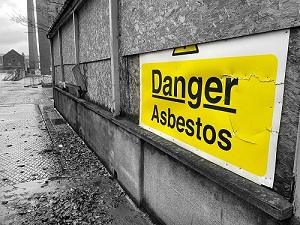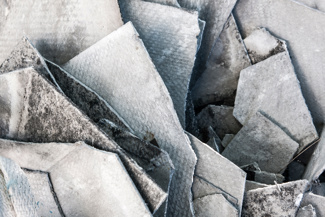Global Asbestos Awareness Week
Global Asbestos Awareness Week is held from 1st to 7th April every year and aims to raise awareness of the associated risks and dangers of asbestos exposure.
We asked David Ratcliffe, Director of Analytical Services, to explain the different types of asbestos found in the UK and the testing methods used in identifying asbestos.
 Asbestos, once hailed for its versatility and durability, has now become synonymous with danger and health risks. The United Kingdom, like many other countries, has a complex history with asbestos, which was extensively used in construction and manufacturing until the devastating effects on human health were fully acknowledged in the 1970s.
Asbestos, once hailed for its versatility and durability, has now become synonymous with danger and health risks. The United Kingdom, like many other countries, has a complex history with asbestos, which was extensively used in construction and manufacturing until the devastating effects on human health were fully acknowledged in the 1970s.
However, it was not until much later, in 1999, that the material was banned outright, and it is the case that many modern buildings constructed before the mid-1980s are thought to contain asbestos.
Today, understanding the different types of asbestos and employing rigorous testing methods are crucial in mitigating its risks.
Types of Asbestos Found in the UK
Asbestos is a naturally occurring mineral fibre prized for its heat resistance and durability. There are six different types of asbestos minerals classified into two categories: Serpentine and Amphibole. Asbestos-containing materials (ACMs) are composed of long and thin fibrous crystals. Each fibre comprises microscopic "fibrils" which if disturbed through demolition and redevelopment activities can be released into the environment.
Chrysotile (White Asbestos) - Chrysotile is the most common type of asbestos found in buildings in the UK and worldwide. It belongs to the serpentine group and was extensively used in insulation, cement, and roofing materials.
Amosite (Brown Asbestos) - Amosite is an Amphibole asbestos commonly used in insulation boards, ceiling tiles, and thermal insulation products. Its considered more hazardous than Chrysotile due to its long, needle-like fibres.
Crocidolite (Blue Asbestos) - Crocidolite is another type of Amphibole asbestos known for its blue colour. It was primarily used in the UK for insulation and lagging, particularly in steam engines and pipe insulation. It is the most lethal form of asbestos due to the asbestos materials tending to be brittle, meaning they break down quickly and release their dangerous fibres which can be inhaled.
Anthophyllite - Although less commonly used than other types, Anthophyllite asbestos can still be found in certain products such as insulation and cement materials.
Tremolite - Tremolite is another Amphibole asbestos found in talc products and as a contaminant in other asbestos minerals. It is rarely used commercially but may be present in certain materials.
Actinolite - Actinolite asbestos is relatively rare and has limited commercial use. It can sometimes be found in certain construction materials and as a contaminant in vermiculite.
Testing for Asbestos in Materials
Given the widespread historical use of asbestos, it's crucial to identify and manage its presence in buildings and products. Testing for asbestos involves several methods to determine whether asbestos fibres are present in a material and, if so, what type of asbestos it contains. Here are some common testing methods:
Visual Inspection - A visual inspection is often the first step in identifying potential asbestos-containing materials (ACMs). Trained professionals examine the material's appearance, texture, and condition to assess the likelihood of asbestos presence. However, visual inspection alone cannot confirm the presence of asbestos.
Sampling and Analysis - Sampling involves carefully collecting small pieces of material suspected to contain asbestos or in the case of soil/made ground collecting a representative sample of the material of interest. These samples are then analysed in accredited laboratories such as our chemistry laboratory in Leicester where we offer UKAS accredited asbestos identification and quantification services.
Air Monitoring - Air monitoring is essential in environments where asbestos fibres may become airborne, such as during renovation or demolition activities. Air samples are collected and analysed to determine the concentration of airborne asbestos fibres, ensuring compliance with safety regulations and protecting workers and occupants from exposure.
Non-Destructive Testing - Non-destructive testing methods, such as X-ray fluorescence (XRF) analysis, can detect the presence of asbestos without damaging the material. XRF instruments can identify elements, including asbestos fibres, by analysing the material's composition.
Risk Assessment - Once asbestos-containing materials are identified, a risk assessment is conducted to evaluate the potential for fibre release and exposure. Factors such as material condition, location, and occupant activity are considered to determine the appropriate management actions, including encapsulation, enclosure, or removal by licensed professionals.
Due to the health risks associated with asbestos exposure, blue and brown asbestos was banned in the UK in 1985. This ban extended to include white asbestos in 1999. While asbestos is no longer used, its legacy continues to pose risks to public health and safety. Understanding the different types of asbestos found and implementing robust testing methods are essential for identifying and managing asbestos-containing materials effectively. By prioritising thorough testing and risk assessment, we can minimise exposure to asbestos fibres and safeguard the well-being of workers and occupants in buildings across the UK.
 Unfortunately, in the construction world, potential contact with asbestos-containing materials can happen frequently, and awareness of the risk of ACMs should be at the forefront of every employer and employee's mind. If you are performing work on a building of any age, you should always request to see a copy of the asbestos register and management survey or in the case of renovation/demolition work request to see a copy of the Refurbishment and demolition survey.
Unfortunately, in the construction world, potential contact with asbestos-containing materials can happen frequently, and awareness of the risk of ACMs should be at the forefront of every employer and employee's mind. If you are performing work on a building of any age, you should always request to see a copy of the asbestos register and management survey or in the case of renovation/demolition work request to see a copy of the Refurbishment and demolition survey.
At CTS, we offer UKAS-accredited asbestos identification and quantification services for bulk and soil samples to support your ongoing projects with fast and accurate results. This helps to ensure the safety of your teams and gives you the required information to develop remediation plans. We also have a Contaminated Materials Testing (Red Lab), helping to assist organisations in aggregates and soil contamination testing.
In addition to our asbestos laboratory testing services, our sister companies within the Phenna Group offer asbestos remediation strategy and verification services.
